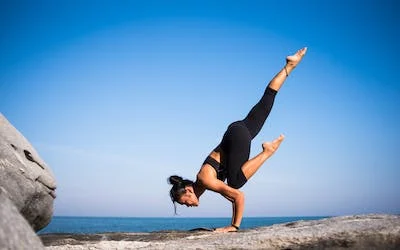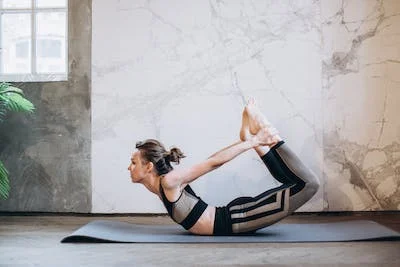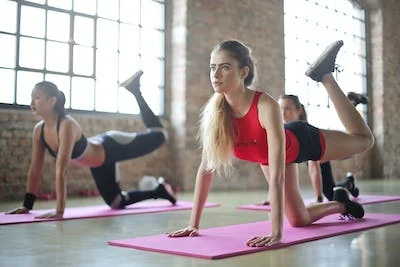Yoga for Flexibility: Benefits Beyond Stretching

Introduction
In the quest for physical well-being, flexibility often takes centre stage. It’s not just about touching your toes or doing a split; it’s about cultivating a body that moves with ease and grace. Enter yoga, a centuries-old practice renowned for its transformative benefits on flexibility.
Understanding Yoga's Approach to Flexibility
Yoga isn’t merely about contorting into pretzel-like shapes; it’s a holistic system that harmonizes body, mind, and breath. Through a blend of asanas (poses), pranayama (breathing exercises), and mindfulness, yoga gradually enhances flexibility. Each pose targets specific muscle groups, releasing tension, and gradually increasing suppleness. The beauty lies in its inclusivity; whether you’re a beginner or an experienced yogi, there’s a practice suitable for every level.
Benefits Beyond Stretching

Flexibility gained through yoga transcends physicality. While it elongates muscles and increases joint mobility, it also nurtures mental resilience. The focus required during practice promotes mindfulness, aiding in stress reduction and fostering mental clarity. As the body loosens, so does the mind, allowing for a deeper mind-body connection.
Embracing Progress, Not Perfection
One of the fundamental tenets of yoga is embracing the present moment without judgment. It’s not about achieving the perfect pose but about honoring your body’s unique capabilities. With consistent practice, noticeable improvements in flexibility emerge gradually, encouraging practitioners to celebrate their progress, no matter how small.

Varieties of Yoga for Flexibility

Several yoga disciplines prioritize enhancing flexibility. Among these, Hatha yoga stands out for beginners due to its slow pace and emphasis on fundamental postures. Meanwhile, Vinyasa flow intertwines seamless movements with breath, fostering flexibility through smooth transitions. For a profound stretch, Yin yoga specifically addresses connective tissues, advocating extended pose durations. These diverse styles present distinct methodologies, guaranteeing a practice that aligns with personal requirements. Whether opting for the gentle foundation of Hatha, the rhythmic flow of Vinyasa, or the deep elongation of Yin yoga, practitioners can find a tailored approach to bolster their flexibility and overall well-being.
Yoga: A Journey, Not a Destination
Yoga is not merely a set of physical postures; it’s a profound journey that transcends the boundaries of the mat. Originating in ancient India, yoga encompasses a holistic approach to well-being, incorporating physical, mental, and spiritual aspects. As individuals delve deeper into the practice, they realize that yoga is more about the journey than reaching a final destination.
The philosophy of yoga revolves around the inter-connections of the mind, body, and spirit. It encourages practitioners to embrace the present moment, fostering self-awareness and inner peace. While yoga offers physical benefits like increased flexibility and strength, its true essence lies in the transformative journey it offers.
In essence, yoga is an ongoing journey of self-discovery and personal growth. It’s not about achieving a perfect pose but about the continuous evolution and exploration of one’s capabilities. Each practice session becomes a unique experience, allowing individuals to delve deeper into their inner selves.

The Science Behind Flexibility Enhancement

Yoga’s impact on flexibility isn’t just anecdotal; it’s backed by science. Regular practice gradually lengthens and strengthens muscles while improving the elasticity of connective tissues. As the body moves through various poses, it stimulates the production of synovial fluid, lubricating joints and enhancing range of motion. This combination of stretching and strengthening not only increases flexibility but also prevents injuries and promotes overall joint health.
Mindfulness and Flexibility: The Symbiotic Relationship
Flexibility isn’t solely a physical attribute; it’s intertwined with mental and emotional states. Yoga’s emphasis on mindful movement and breath awareness cultivates a sense of presence. By syncing breath with movement, practitioners learn to listen to their bodies, identifying areas of tension and releasing them gradually. This union of mindfulness and movement not only enhances physical flexibility but also nurtures emotional resilience and mental clarity.

The Role of Breath: A Catalyst for Flexibility

Yoga’s impact on flexibility isn’t just anecdotal; it’s backed by science. Regular practice gradually lengthens and strengthens muscles while improving the elasticity of connective tissues. As the body moves through various poses, it stimulates the production of synovial fluid, lubricating joints and enhancing range of motion. This combination of stretching and strengthening not only increases flexibility but also prevents injuries and promotes overall joint health.
Overcoming Flexibility Plateaus
It’s common to encounter plateaus in flexibility. The body adapts, and progress might seem stagnant. However, this phase serves as an opportunity for exploration. Variations of poses, incorporating props like blocks or straps, and exploring different yoga styles can break through plateaus, inviting fresh challenges and encouraging further flexibility gains.

Flexibility in Daily Life: Beyond the Mat

Flexibility cultivated through yoga doesn’t confine itself within the boundaries of a yoga mat; it seamlessly integrates into our daily routines. Beyond the physical stretches, the agility gained impacts how we navigate everyday life. Enhanced flexibility extends its benefits, making mundane tasks more manageable while lowering the chances of injury.
One notable effect is the refinement of posture. With improved flexibility, the body naturally aligns itself, reducing strain on muscles and joints during activities like sitting at a desk or lifting objects. This translates into increased comfort and decreased chances of discomfort or pain.
Moreover, heightened mobility due to regular yoga practice allows for easier movements in various scenarios. Whether reaching for items on high shelves or bending down to tie shoelaces, the increased range of motion facilitates these actions effortlessly.
Additionally, yoga promotes a heightened sense of body awareness. This awareness aids in recognizing and preventing potential injuries, as individuals become more attuned to their body’s limitations and signals.
In essence, the flexibility gained through yoga isn’t confined to the mat; it becomes a part of how we move, sit, and engage with the world around us, fostering a more adaptable and injury-resistant lifestyle.
Customizing Your Practice: Personalizing Flexibility Goals
Every body is different, and so are its capabilities. Tailoring a yoga practice to individual needs is pivotal. Setting realistic flexibility goals, listening to the body’s signals, and honoring its limitations fosters a safe and effective practice. Whether aiming for deep stretches or focusing on overall mobility, customization ensures a practice that nurtures without strain.

Conclusion: Embrace the Journey of Flexibility
Yoga for flexibility isn’t just about touching your toes; it’s a holistic expedition encompassing physical, mental, and emotional growth. It’s an invitation to explore the body’s potential, embrace its fluidity, and cultivate a deeper understanding of self. Through the union of movement, breath, and mindfulness, yoga for flexibility offers a transformative journey, unlocking the power of flexibility in body, mind, and spirit.
Frequently Asked Questions (FAQs)
Can yoga really improve flexibility?
Yes, yoga systematically elongates and strengthens muscles, gradually enhancing flexibility. Regular practice lengthens connective tissues, improving joint mobility and range of motion, leading to noticeable improvements in flexibility over time.
How often should one practice yoga for improved flexibility?
Consistent practice is key. Aim for at least 3-4 sessions per week to observe significant improvements in flexibility. Regularity and dedication are vital in reaping the benefits of enhanced flexibility.
Are certain yoga poses better for increasing flexibility?
Absolutely, poses like Downward Dog, Forward Fold, Cobra, and Pigeon are renowned for stretching and lengthening muscles, promoting flexibility in specific areas like hamstrings, spine, and hips.
Can beginners with low flexibility practice yoga?
Absolutely, yoga is inclusive. Beginners can start with gentle poses and modifications, gradually building flexibility. It’s about meeting your body where it is and progressing at your own pace.
How long does it take to notice flexibility improvements with yoga?
Results vary based on individual factors, but with consistent practice, noticeable improvements can surface within a few weeks to a few months, depending on dedication and body response.
Is it okay to feel discomfort during yoga for flexibility?
A mild discomfort is normal, but pain isn’t. Listen to your body; discomfort may signify stretching, but pain indicates strain. Modify poses or ease into stretches to avoid injury.
Can yoga help with flexibility-related injuries?
Yes, yoga aids in preventing and rehabilitating injuries by gradually improving flexibility and strengthening supportive muscles, promoting better alignment and mobility.
Are props like blocks or straps beneficial for flexibility?
Absolutely, props assist in achieving proper alignment and support in poses, aiding in deeper stretches and gradually improving flexibility without strain.
How does yoga for flexibility benefit athletes or fitness enthusiasts?
For athletes or fitness enthusiasts, improved flexibility translates to better performance, reduced risk of injuries, enhanced recovery, and improved overall movement mechanics.
Can yoga for flexibility be practiced at any age?
Yes, yoga is adaptable. Whether young or old, practicing yoga fosters flexibility at any age, promoting joint health and improving overall mobility for a more agile life.
One Response